The dog is getting a bit cheeky.
Christmas is a very busy time of year for me. It is the only time of year when having long white hair and a beard can actually lead to gainful employment. I have been so busy polishing my Reindeer’s hooves (and keeping them off the Fly Agaric) that I haven’t had time to write a proper post.
What would you like for Christmas, little fellow?
A puppy? Oh I think that we could manage that….
 What do you mean, “You want a cute one?” Get out’a here!
What do you mean, “You want a cute one?” Get out’a here!
 Oh shut up! You wouldn’t give me away.
Oh shut up! You wouldn’t give me away.
🙂
So anyway this is the best that I could manage today. It is a rehash of something that I posted elsewhere.
Clematis vitalba, The Wild Clematis
Clematis vitalba also known as Old Man’s Beard or Traveller’s Joy.
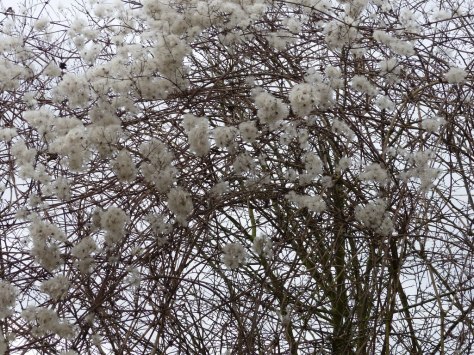 I see Old Man’s Beard in the winter.
I see Old Man’s Beard in the winter.
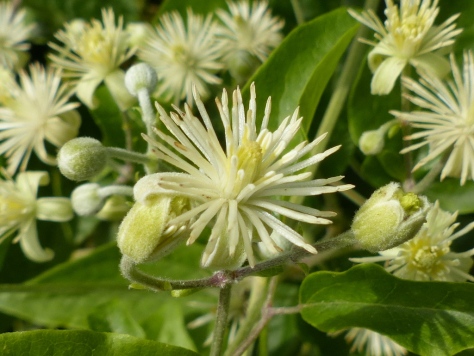 Traveller’s Joy in the summer.
Traveller’s Joy in the summer.
Other less common names relate to it’s use as a tobacco substitute, for example, Smoke Wood or Boy’s Bacca. The woody stems contain large vessels which allow air to pass through them and it was once the habit to break off pieces of the stem and smoke it like a cigar.
Clematis vitalba is a member of the Buttercup family and the only member of that family to have woody stems.
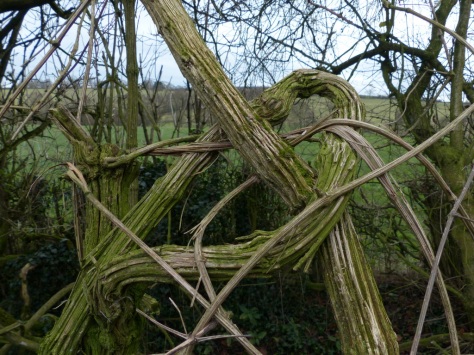 Native to the UK and most common in the south , it is a climbing vine or Liana. It’s roots are in the soil and it climbs toward the light by curling the stems of it’s leaflets around trees and shrubs.
Native to the UK and most common in the south , it is a climbing vine or Liana. It’s roots are in the soil and it climbs toward the light by curling the stems of it’s leaflets around trees and shrubs.
Old Man’s Beard is a familiar sight in the winter scrambling through and topping the hedgerows.
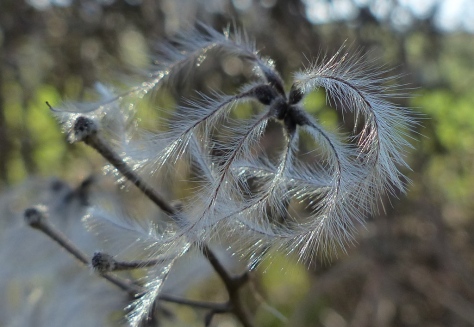 The leaves are made up of three to five leaflets on a central stem and these leaflets are spaced apart with two opposite pairs and one at the end. It is usually five, three leaflets are only common on young plants.
The leaves are made up of three to five leaflets on a central stem and these leaflets are spaced apart with two opposite pairs and one at the end. It is usually five, three leaflets are only common on young plants.
The ability of these leaflets to curl around anything they find in their way is central to the success of the plant. An unsupported vine can only grow toward the light for about one metre before it drops and grows along the ground.
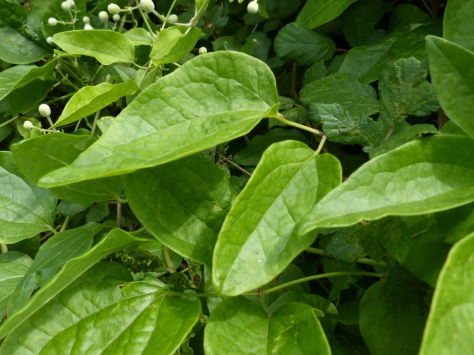 In the UK the flowers open in the second half of July.
In the UK the flowers open in the second half of July.
 The flowers don’t have petals. They have four sepals which open to reveal numerous stamens and styles. The flower is hermaphrodite.
The flowers don’t have petals. They have four sepals which open to reveal numerous stamens and styles. The flower is hermaphrodite.
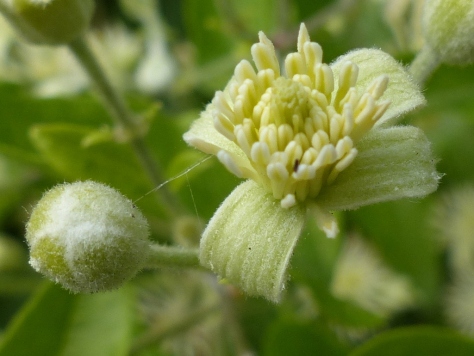
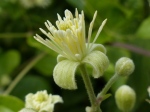
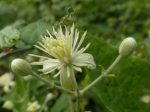
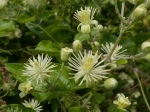
 The late summer flowers often coincide with the ripening fruits of the plant that they are climbing, as in these next pictures of the vine growing through Elder.
The late summer flowers often coincide with the ripening fruits of the plant that they are climbing, as in these next pictures of the vine growing through Elder.
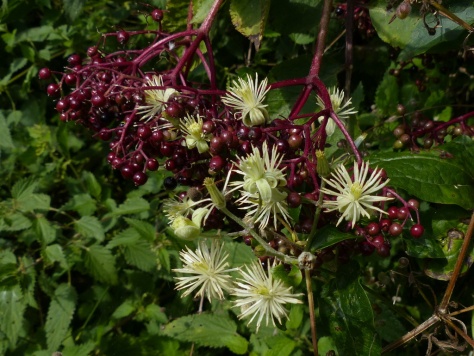
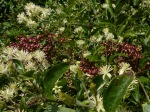
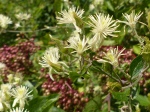
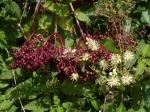
 As the Elder berries are ripening so is the Clematis. The sepals and stamens are discarded and the green seeds form at the base of the styles.
As the Elder berries are ripening so is the Clematis. The sepals and stamens are discarded and the green seeds form at the base of the styles.
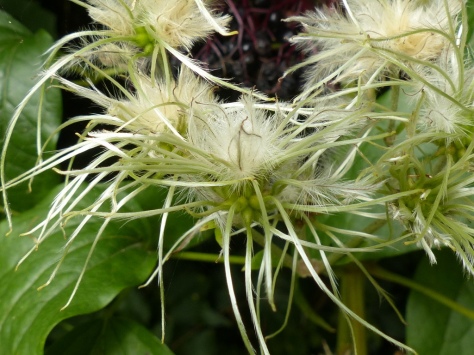 The styles start to elongate and become feathery. They will remain attached to the seed and serve to distribute the seed on the wind.
The styles start to elongate and become feathery. They will remain attached to the seed and serve to distribute the seed on the wind.
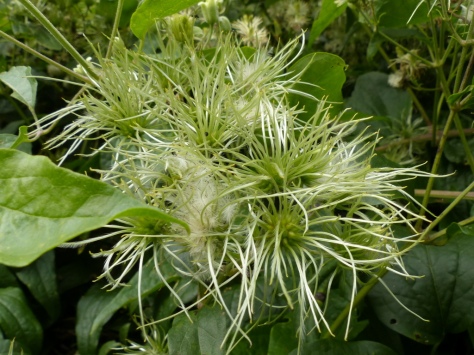 The host plant in these next pictures is Hawthorn. I just mention this in case anyone thinks that Wild Clematis has berries of any kind. Of course it doesn’t, the seeds that we are looking at are its fruit.
The host plant in these next pictures is Hawthorn. I just mention this in case anyone thinks that Wild Clematis has berries of any kind. Of course it doesn’t, the seeds that we are looking at are its fruit.
 The seeds change from green to brown as they ripen.
The seeds change from green to brown as they ripen.
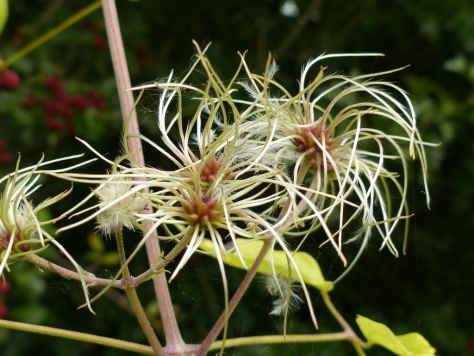


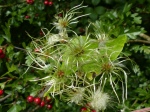 In September the summer flowers start to turn into the Old Man’s Beard that will hang on the vines all winter, often lasting well into April or even May.
In September the summer flowers start to turn into the Old Man’s Beard that will hang on the vines all winter, often lasting well into April or even May.
The seeds provide a valuable source of food for birds throughout the winter.
This vine is very important to our wildlife. Apart from the seeds provided for the birds the flowers are a rich source of nectar for visiting insects and the leaves provide the larval food for several native moths. In fact there are several species that are completely dependent on Clematis vitalba as their sole larval food plant, these include the Small Emerald Moth, The Small Waved Umber and Haworth’s Pug.
 Native to the UK and much of Southern and Western Europe these vines play a vital role in our ecology. They fit well into our crowded hedgerows and they do not outgrow themselves. Elsewhere in the world they are much less welcome.
Native to the UK and much of Southern and Western Europe these vines play a vital role in our ecology. They fit well into our crowded hedgerows and they do not outgrow themselves. Elsewhere in the world they are much less welcome.
It is particularly unwelcome in New Zealand where it is considered an “unwanted organism” and a “national pest.” A milder climate and a lack of natural control agents means that Wild Clematis grows much more vigorously over there. The flowers only open in full sun and the habit of the vine is to grow to the top of the tree before flowering. The leaves smother whatever it is growing through and deprive the host plants of sunlight.
Even here it can cause problems. The vines can grow as thick as your wrist and more.
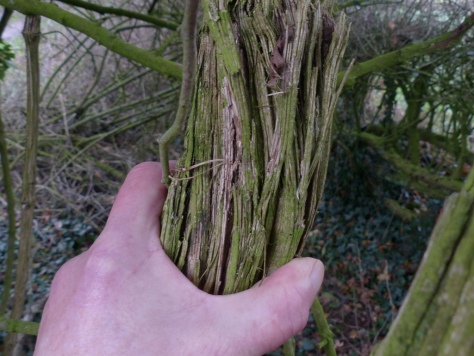 They can hang from a tree in great numbers and mass. Their sheer weight and wind resistance can be enough to break branches or even topple a tree.
They can hang from a tree in great numbers and mass. Their sheer weight and wind resistance can be enough to break branches or even topple a tree.
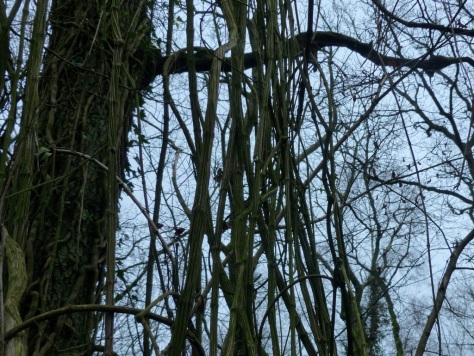 However they do also provide the only real opportunity in the UK to play Tarzan and swing through the jungle and for that they should be valued. (you can swing on them but just like Tarzan, you may hurt your bum if they break)
However they do also provide the only real opportunity in the UK to play Tarzan and swing through the jungle and for that they should be valued. (you can swing on them but just like Tarzan, you may hurt your bum if they break)
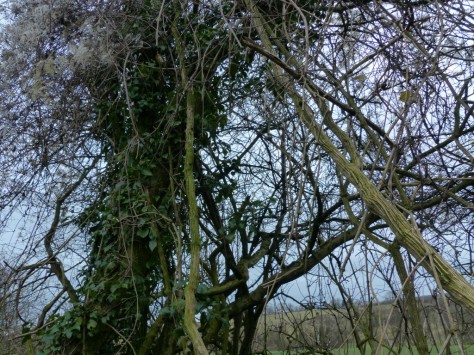 I have heard it said that the stems make a good natural tinder for starting a fire but in my experience I think that it absorbs moisture very easily and in winter it is always wet and useless. It needs to be dry, perhaps in summer. (The feathery seeds dry quickly and are like cotton wool for taking a spark but they don’t last long)
I have heard it said that the stems make a good natural tinder for starting a fire but in my experience I think that it absorbs moisture very easily and in winter it is always wet and useless. It needs to be dry, perhaps in summer. (The feathery seeds dry quickly and are like cotton wool for taking a spark but they don’t last long)
Taxonomy:
Kingdom: Plantae
Order: Ranunculales
Family: Ranunculaceae
Genus: Clematis
Species: Clematis vitalba
That last picture was taken yesterday and is exactly how things are here in the UK in December 🙂



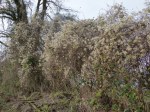
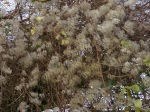
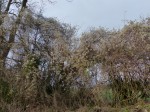

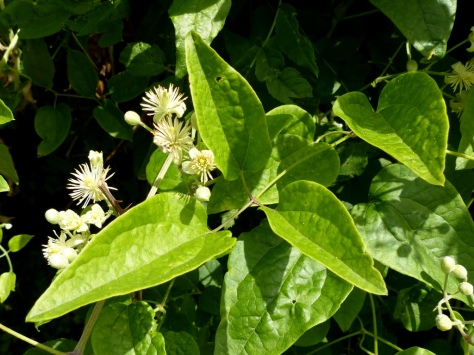
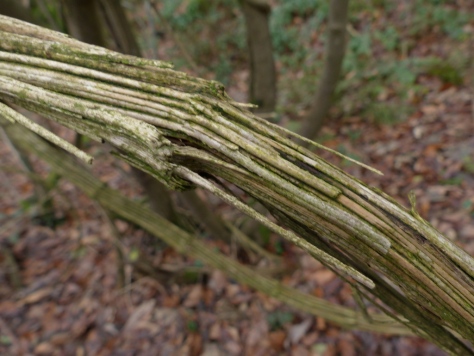
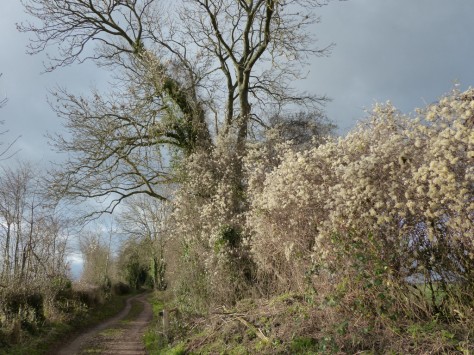
As Clematis climbs which way does it go? Looking from above, is it clockwise or anticlockwise? And is it opposite in the Southern Hemisphere? This is not a quiz, Fizz. It is a genuine request for information.
LikeLiked by 1 person
Thanks John 🙂 That is a very good question and at this point in time I have to say that I don’t know. I was going to say that it doesn’t climb like that. Honeysuckle, for example, is a clockwise climber and always twists in the same direction but with this Clematis the vines don’t entwine but obviously the leaflets do. I haven’t looked and I don’t know where I could find that information. I will investigate and get back to you. This is something that we must know.
LikeLike
I’ve seen the plant but hadn’t heard its names before, or how important it is to wildlife. Thanks to you and Fizz for sharing your knowledge.
LikeLiked by 1 person
Thank you Emily 🙂 There is so much stuff out there, nobody knows all of the names but it is always nice to be able to put a name to something. It makes me feel closer to the species when I know a little about it. Glad we were able to help.
LikeLiked by 1 person
It is the same with me…’inquiring minds need to know!’
LikeLike
You are quite right – Old Mans Beard is an absolute pest here. (not yours of course, so don’t feel you have to shave)
LikeLiked by 1 person
Thank you Maureen 🙂 Yes but… Yes but…. I didn’t take it to NZ, it was one of your lot that brought it over and you have only yourselves to blame. It is not even the best garden plant, what on earth were you thinking? 🙂 Okay I think that I read somewhere that it was brought to NZ to use as a rootstock to graft fancy Clematis to. The problem really is gardeners, they get everywhere 🙂
LikeLike
Itzme back again. I thought you would know 100% So I did a bit of a check myself. Apparently lots of vines grow anti-clockwise but it doesn’t matter if it’s in the Northern or Southern hemisphere. If you wanna know here is a start.
http://www.granny-miller.com/do-you-know-which-way-vines-grow/
LikeLike
Interesting stuff John 🙂 I think that we need to be clear on how we determine the direction. My walking stick has Honeysuckle growing up it so… I hold my stick from the bottom and following the direction of the upward growth I turn my stick, my stick is turning clockwise. If I was to look down from the top of the vine then my stick turns anti-clockwise as I follow the vine up but that is not the way that the plant grew. Which way are you looking?
LikeLike
This is easier to understand.
This is my clockwise Honeysuckle (sorry Fizz)


and pinching a picture from the link that you sent me. This is that lady’s counter clockwise Morning Glory.
I will try and find out which way the Clematis grows but most of the leaves have gone now. There may not be much evidence 🙂
LikeLike
I’m holding your stick on the ground and as I start from the ground I follow the vine and it is growing which way?
LikeLike
After extensive research and a field trip I have come to the conclusion that the herb is degenerate, it does not follow the ways of the clock.
Now I remember reading somewhere that Darwin experimented with this plant and found that by repeatedly stroking one side of the stem for half an hour he could make it turn back on itself. That wouldn’t have told me which way that it climbed but it does suggest that the trigger to turn may be contact rather than some genetic programme to turn clockwise or otherwise.
LikeLike
An excellent post for a nature lover or anyone for that matter: sea of information with outstanding photos…
LikeLike
Thank you so much for those sweet words Bethula 🙂
LikeLiked by 1 person
Beautiful photographs! I especially like the one you took yesterday and the one of the seeds shining in the sun (just before you speak of the leaves and leaflets). I see plenty of Old Man’s Beard when I’m driving my car but none on my walks, unfortunately.
LikeLike
Thank you Clare 🙂 I really wasn’t going to take that last photograph and then the sun came out and lit up the scene and it had to be done. The days are so dark and short now but I think that we are at a turning point 🙂
LikeLike
I looked this up in Flora Britannica and it is also known as Woodbine, Capstan Full Strength and Strand. Superb work, Colin. You need to collate these into a book. I hear Fizz Publishing is on the look out for new work.
LikeLike
Thank you Andrew 🙂 There is a book, these are the pages of Easy Wildflowers but it is just the bones of a book at the moment. I do want to create something that is more than a blog, something that is one day useful but it takes time 🙂
LikeLiked by 1 person
At a quick glance, the fluff in the bottom photo almost looks like snow. We have “clematis” in Canada but it is very different looking and definitely not invasive. The blooms are hard-won for gardeners in my patch of the planet.
LikeLike
Thank you Susanne 🙂 There are a lot of different Clematis varieties. I don’t think my one would do very well in Canada, it would be in it’s winter clothes all year round.
LikeLike
Hi Santa, I want a puppy for Christmas!
LikeLike
Thank you Sandi 🙂 Sorry that Fizz has been absent from FB the last day or so but she has been very busy helping Santa. She will be back soon 🙂
LikeLike
She’s such a faithful little girl. Have you made her one of your elves?
LikeLike
We have it here as well and it sure is invasive and you need to tend it in areas where it will take over. Locally we call it Pappy’s Whiskers. The smell of the flowers makes it worth letting some grow in the edge of the yard or somewhere out of the way like that. Lovely pictures today, as always.
LikeLike
Thanks Sarasin 🙂 Non-native certainly but I am surprised that you have problems with it in Pennsylvania. It seems to be on the edge of it’s Northern border here and to prefer warmer climes. I had PA down as being quite a bit colder than here, especially looking at your winter posts from last year. (brrrrr…..) I agree with you about the scent, some people say that it is unscented or very faint but I think that depends on how fresh the flowers are, they lose the scent as they age.
LikeLike
Our winters do get very (too) cold here Colin, but yet it thrives and takes over areas if allowed to. I purposely allow it to grow on a guy wire attached to a utility pole on the side of my yard, just to get to smell those flowers for a short time. Some other places where it has sprung up, I guess by seed, I have to fight it.
LikeLike
Beautiful pictures 🙂 I bet smoking those would be healthier than what’s sold in the shops! Wishing you a merry Christmas x
LikeLike
Thank you Sharon 🙂 I had beautiful flowers to work with. A very merry Christmas to you and yours too x 🙂
LikeLiked by 1 person
That’s true, the same to you TYSM 🙂 x
LikeLike
Just tell Fizz there aren’t any puppies as cute as her.
LikeLike
Thank you Don 🙂 She knows that.
LikeLike
Fascinating! Love reading about the ‘wildlife’ there.
LikeLike
Thank you Steven 🙂
LikeLike
From what I have observed from our garden variety clematis here, it would seem that they are driven by contact. But my curiosity was always in how they were able to *sense* the closest item to grasp and reach for it. I tried an experiment to fool them but they seemed to “know” the shortest path to contact. It is interesting that others are curious about which way the twine twirls! In any case, lovely photos of beards 😉 And Fizz, well she is bizzy as usual 🙂
LikeLiked by 1 person
Thank you Stephanie 🙂 If as Darwin observed plants are sensitive to contact then maybe we should open our minds to the idea that they can feel things. If they have feelings then might they also have emotions? I am going to express my love, just in case. 🙂
LikeLiked by 1 person
Good idea, I’m with you on that. Would also like to wish you a Merry Christmas, Happy New Year and many inspired posts!
LikeLike
Love the way you take the time to describe your pictures. I can picture my dog Rascal playing with Fizz. Thanks for the pictures and information. Friends for ever.
LikeLiked by 1 person
Many thanks Roy 🙂 Always good to make a new friend.
LikeLike
Thank you for the beautiful photos. We had what we call Pappy’s Whiskers growing up one support outside our carport. We enjoyed the sweet aroma. It did require some maintenance, but it was worth the effort.
I hope you and sweet Fizz have peaceful holidays..
Incidentally, I live in PA also and it is a lovely place to reside.
LikeLiked by 1 person
Thank you Ettel 🙂 I hope that you had a wonderful Christmas.
LikeLike
Thank you Colin. Christmas was great and today is a quiet New Year’s day. Hopefully yours was the same. May 2015 be a kinder one than the year we just closed.
LikeLike
Colin, somehow I have lost contact with you! I miss daily reads,. I was in thru Google, added my email address several days and no email response. I was reading about garlic and the lovely flowers, the buzzard and dear Fizz’s photos. Miss you both.
LikeLike
Dear Ettel, I have been worrying about you for a few days now and this morning I started looking back over my posts for your last comment. First off I am glad that you are okay 🙂 Will you see this? I don’t know. If you do then if you just Google for “A Tramp in the Woods” Then you should find me. My blog email is fodrambler@gmail.com. Do not worry, I am coming to look for you. Colin (I have a tracker dog) 🙂
LikeLike
Colin…I just read your comment below..and I”m glad you have a tracker dog..I hope we are in communication again. I have recorded both addresses and checked that i want to be notified by email of new comments. Thank you for taking the time. I look forward to many great visits.
LikeLike
A very interesting post like always, and a great start to 2015. I’ll be looking forward to many more just like this one, so have a great year and we’ll see you later.
LikeLike
beautiful and interesting!
LikeLike
A really interesting post with, as usual, lots of info and a doggy superstar. Happy New Year to you and yours!
LikeLike
Thank you for the wealth of information. The “old man’s beard” looks so pretty, such a pity it is an invasive some places. I am in NW of US and we have some invasive plants brought by early English settlers. Scotch Broom and English Hawthorn are a constant battle on our acreage. Apparently the early settlers thought they could not live without these dear plants!
LikeLike
Beautiful and very interesting flowers, and I love your dog!
LikeLike
Thanks for the beautiful photos ; your posts are such an education– I feel like I’m back in school .
LikeLike
My mother-in-law and I pronounce Clematis differently, and now she’s got me doing the emphasis on the first syllable rather than the second (CLEM-atis vs. cleMATis). How do you say it? Well, I guess it doesn’t matter much but was curious. Love the photos, especially this time of year when it’s nice to be reminded of ongoing life in nature and the wilderness. Cheers, – Bill
LikeLike